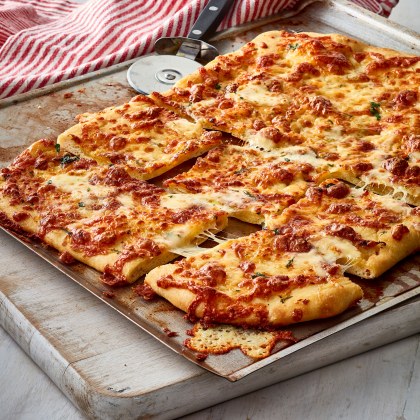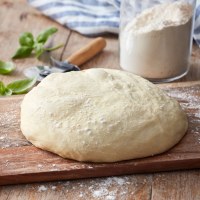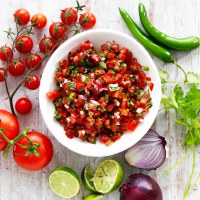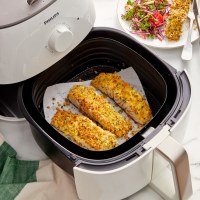The secret to thin crust pizza
You can achieve thin crust pizza at home with these easy tips! Making the right dough, balancing the toppings and crust, getting a roaring hot oven and transferring the pizza are all things to consider before you get started on your ultimate homemade pizza. Get the secrets to crispy thin crust pizza and start cooking!
How to make pizza dough
Not all pizza doughs are created equal. This quick recipe for basic pizza dough is beginner-friendly, can be rolled either thick or thin and makes enough for 2-3 pizzas. Don’t have time to start from scratch? Support local and buy fresh pizza dough from your local pizza restaurant. They’re usually all too happy to part with some of their fresh dough for a small fee. Alternatively, supermarkets sell ready to roll pizza dough and pizza bases.
Ingredients
2 tsps (7 g sachet) dried yeast
1 cup (250 ml) lukewarm water
400 g (2 2/3 cups) plain flour, plus extra to dust
2 tsps salt
3 tbsps (1/4 cup) olive oil
1 cup (250 ml) lukewarm water
400 g (2 2/3 cups) plain flour, plus extra to dust
2 tsps salt
3 tbsps (1/4 cup) olive oil
Method
- Whisk yeast and water in a heatproof jug. Stand for 5 minutes or until frothy
- Place flour and salt in a large bowl. Make a well in the centre. Pour in the yeast mixture and oil. Using your hands or a spatula, mix the dough until it comes together and is smooth. Turn out onto a lightly floured work surface and knead briefly
- Place dough in a lightly oiled bowl and cover with cling wrap. Set aside in a warm place to rise for 30 minutes to an hour until it doubles in size
- Turn dough out onto a lightly floured surface and knead gently for another 5 minutes or until smooth. Divide dough and roll out pizza bases to desired size. Sprinkle a little flour on the bench before rolling to prevent dough from sticking. Your dough is now ready for your favourite pizza topping
Get the recipe that you can save to your myfoodbook cookbook here: Basic Pizza Dough
TIP: For more help making pizza dough, read this guide to how to make pizza dough.
How to roll out pizza dough for thin crust pizza
Rolling out the pizza nice and thin is of course a very important step. Be patient and gentle at this step to avoid tearing your dough.
- Lightly flour your work surface, rolling pin and the top of your dough with flour.
- Starting from the centre of your dough, roll out to the edges with even pressure.
- Lift dough and make a quarter turn to form until you have a uniform round pizza the size of your pan or pizza stone.
TIP: Before you start adding toppings, move your dough to whichever pan or tool you’ll be using to transfer it to the oven.
Why can’t I roll out my pizza dough?
If your dough keeps springing back and you can’t roll it out, reroll into a ball and cover with a cloth or an upturned bowl. Rest for 15-30 minutes. This allows the gluten strands to relax, and it should roll out without as much resistance when you try again.
Room temperature dough will also be easier to roll and stretch than cold dough. If you’ve refrigerated or frozen your dough, allow to come to room temperature before trying to roll it.
Tips for thin crust toppings
Toppings can easily make or break your thin crust pizza, as they have a big effect on how the crust cooks. Follow these essential rules for beautifully crispy pizzas:
- Add only a thin layer of sauce, just enough so you can still see the dough through the sauce.
- Less is more. After adding cheese and sauce, aim for only 3 or 4 extra toppings. Too many ingredients add excess moisture, slows down the cooking and will lead to a soggy, undercooked crust. Too much weight from the toppings can also lead to a floppy pizza that falls apart.
- Use the right type of good quality cheese for great flavour, colour and melt. The wrong cheese will turn oily and lumpy, the right cheese will become golden and stretchy. Learn more about the best cheese for pizza here.
BONUS TIP: Add fresh soft herbs such as basil or rocket to dial up the flavour without affecting how your crust cooks. Always add them once your pizza comes out of the oven. The residual heat will wilt and warm the herbs, bringing out their flavours.
How to cook thin crust pizza
Now your dough is rolled, topped and ready, it’s time to heat things up!
What temperature should you cook pizza?
Commercial pizza ovens reach up to 400-500°C and cook a thin crust pizza in as little as 90 seconds, so don’t be afraid to get your oven at home as hot as possible. Higher heat = crunchier and tastier crust. Most home ovens only reach 240-250°C, though some have a specific ‘pizza’ setting. For the best results, preheat your oven and pizza stone or pan on the lower-middle shelf for at least half an hour before cooking your pizzas. Your oven will be as hot as possible, and you'll lose less heat when you open it to put your pizzas in.
What is the point of a pizza stone?
Traditionally, thin crust pizzas are cooked right on the hot concrete or brick surface of a pizza oven. The quick transfer of heat from the surface to the dough is what gives the crust that amazing crisp lightness. There are a few ways to achieve this at home, one of them being a pizza stone. Pizza stones are a piece of ceramic that's preheated to replicate the surface of a pizza oven. Build your pizza, then place your pizza onto the hot pizza stone using a pizza peel.
What to use instead of a pizza peel
If you don’t have a pizza peel, build your pizza on a sheet of baking paper and transfer pizza and paper together onto the preheated pizza stone. You can use a rimless baking tray to help with this. Halfway through the cooking time, open the oven and quickly remove the baking paper.
TIP: Check the maximum recommended temperatures for the baking paper so you don’t incinerate the paper and pizza together.
What to use instead of a pizza stone
If you don’t have a pizza stone, you can use a rimless baking tray or upturned baking tray. Preheat it as you would preheat a pizza stone, before placing the pizza onto it using a pizza peel or baking paper.
The easiest technique is using a pizza pan. Place the rolled dough directly into the cold pan, add toppings, and then place in the preheated oven. You won't get quite the same crispy crust, but you’ll still end up with a tasty pizza. Perforated pizza pans let heat in faster and give a better finished slice.
Pizza topping ideas and recipes
Click to check out lots of pizza topping ideas or check out some classic topping ideas below.
GET THE RECIPE: Cheesy Herb and Garlic Pizza by Perfect Italiano
Look how thin you can roll this pizza dough! The simple flavours on this pizza means that every flavour shines, especially the golden bubbling cheese.
GET THE RECIPE: Cheesy Pizza Puffs Three Ways by Perfect Italiano
When you really want crispy thin crust with no effort, why not use puff pastry to make these cheesy pizza puffs instead. Get lots more crispy puff pastry ideas here!























